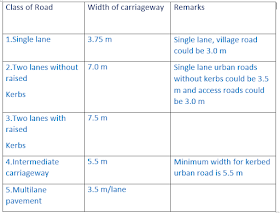Design Speed:Most
important factor controlling the geometric design
elements of highways.
>>Factors considered in India
for deciding design speed are
- Importance of road
- Terrain or Topography
>> For rural highways two types
of Design Speeds
- Ruling Design Speed : The speed that should generally be considered as guiding extension for correlating the various design features.
- Minimum Design Speed: The speed that should be adopted in sections where site conditions or economics do not permit a design based on the ruling design speed.
>>Highway cross section element:
>>
Pavement surface characteristics:
Friction (or Skid resistance):
- Determines operating speed, distance requirements in stopping, accelerating,
- For calculation of SSD, IRC has recommended longitudinal frictional coefficient 0.35 to 0.4.
- In the case of horizontal curve design, lateral coefficient of 0.15 is recommended.
- Coefficient of friction is less when pavement surface is smooth and wet.
- Also decrease with increase in temperature, type pressure and load.
- New tyres are more dependable than smooth and old ones in adverse surface and conditions like wet.
- Smooth and worn out tyres offer higher friction factors on dry pavement than new types with threads.
Longitudinal
coefficient of friction (f) as per IRC Pavement Unevenness
Measured by
unevenness index (using unevenness indicator) which the cumulative vertical
undulations of the pavement surface per unit horizontal length of road (cmlkm).
It should be low.
For good
pavement =150 cm/km.
- 250 cm/km is satisfactory for design speed of 100 kmph.
- Value greater than 320 cm/km is very uncommon table even at speed above 55 kmph.
- Important Instruments: Rougho meter, Bump Indicator
Camber or
cross slope:
Functions: To drain off the rain water from the road surface.
Better surface drainage is important
from considerations of
- Prevention of entry of surface water into subgradesiit1hrough pavement
- To make the surface dry soon after the rain so that skid resist e does not reduce. Designation: As ‘1’ in ‘n’ (1 V: ‘n’ H) or as percentage (%).
Factors:
(A) Type of
pavement surface
(B) Amount
of rainfall
Types of Camber based on shape
(a) Parabolic or elliptic shape
Merit: Profile will be flat at the
middle and steeper towards the edges. It is preferred by fast moving vehicles as
they have to frequently cross the crown line during overtaking operations.
Demerit: Since steeper at edges slow
moving vehicles have a tendency to overturn Inside and hence try to occupy the
central portion of the road way, resulting in reduction of traffic capacities
b) Straight line camber:
Generally in cement concrete pavements, the wheels does not have contact at centre when straight camber iš provided or when vehicle is on a curved cross slope.
Merit : Uniform cross slope on either side
of centre, comfortable for slow moving vehicles
Demerit: Discomfort for fast moving vehicles which
have a tendency to overtake slow moving vehicles by crossing the centre line, which
is a sharp point, resulting in jerk. Further the road is likely to get damaged
at the centre, Since stress intensity is high because of sharp point of
negligible area.
c) Combination of straight and parabolic slope:
This is
particularly useful to increase the area of contact of the wheel and this
decrease the contact straight pressure in case of animal drawn vehicles with
steel types occupying different lateral positions of the pavement.
Merits: It has the positive points of both parabolic
and straight cambers. i.e., comfortable for both slow and fast moving vehicles
and less damage to the road,
Relation
between longitudinal gradient and camber: For better drainage and smooth flow
of traffic the camber (C) of the road should be approximately equal to half of longitudinal gradient (G). i.e., G = 2C.
NOTE: Superior the road flatter the camber
Width of Pavement or carriage way:
>>The
maximum width of vehicle as per 1RC is 2.44 m.
>>The
number of lanes depends on
- Predicted traffic volume
- Traffic capacity of each lane.
Width of
Carriage Way
NOTE: The width of pavement is increased
on horizontal curves, to take care of off tracking and psychological effects is called extra widening.
Traffic separators or medians:
Traffic separators or medians:
Main
function: To prevent
head on collision.
>> IRC
recommends a minimum desirable width of 5.0 m for medians of rural highways.
>> In
long bridges, it may be up to 1.2 m.
Road Margins:
Shoulders:
>> Serve
as emergency lane. Also act as service lanes for vehicles that have broken
down.
>> The
surface of shoulder should be rougher than the traffic lanes so that vehicles
are discouraged to used the shoulder as a regular traffic lane.
>>The minimum shoulder width recommended by the IRC is 2.5m.
>>The minimum shoulder width recommended by the IRC is 2.5m.
FORMATION WIDTH OF VARIOUS ROADS:
Frontage
Roads: Are provided to
give access to properties along an important highway with controlled access as
express way or free way.
Drive Ways: Connects the high way with commercial
establishments like fuel stations, service stations etc.
Guard Rails: When embankment height is more than
3 in.
Width of road way or formation:
Formation Width = Carriage way width (including
separators) + shõulders
>> It
is the top width of highway embankment (or) bottom width of highway cutting excluding
side drains.
Right of Way : Area of land required for the road, along its alignment. The width of this acquired land is known as land with.
The right of way or road land =
formation width + road margins
>> ‘Building
Line’ with sufficient set back from road boundary. In addition to this, it is
desirable to exercise control on the nature of building up to control lines.
>> Normal
land width required for NH and SH is 45 m
>> Maximum
land width required for NH and SH is 60 m
>>corresponding
distance between building lines is 80 m and between control lines is 150 m.







No comments:
Post a Comment